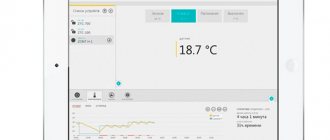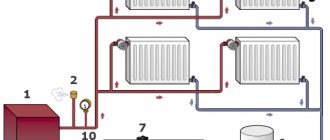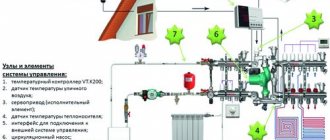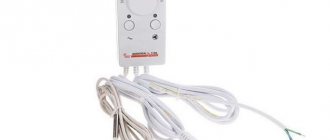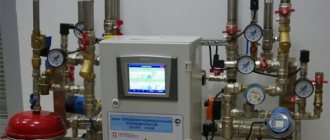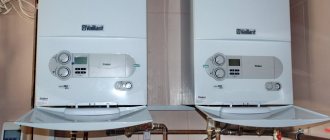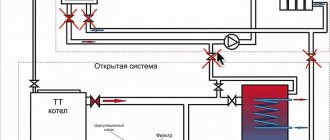Quite expensive and not all models of heating boilers are equipped with a GSM module. However, you can purchase it and connect it yourself, both to expensive and to the most budget models. The main thing is that the boiler must be able to connect external control, which, however, is the norm for almost all modern boiler units.
The cost of the device is on average 4-7 thousand rubles, which is quite a lot and comparable to good programmable thermostats, which are a more modern solution. However, GSM boiler control involves transmitting commands from anywhere in the country where there is cellular communication, while the thermostat’s coverage area is limited to the house itself or the range of home Wi-Fi. Therefore, the additional installation of a GSM module today is still more than justified.
What are GSM modules for heating boilers?
A GSM module is a small device (controller), which essentially represents an alternative to boiler controls and automation. It receives a signal via cellular communication and transmits a command to the boiler or in the opposite direction: it informs about the status and operating parameters of the boiler and the heating system as a whole.
Why is it needed and how is it used
Typically, the primary purpose of purchasing a device is to save money and increase the operating comfort of the heating system. Any GSM module allows:
- turn the heating boiler on or off completely;
- control the temperature, for example, lowering the temperature during absence in order to significantly save money and restoring a comfortable mode even before arriving at home;
- manage DHW circuit temperature parameters;
- External temperature sensors included with almost any modern module allow you to more accurately maintain the temperature by measuring the air temperature in the room, rather than the temperature of the coolant. It is also possible to organize weather-dependent operation of the boiler.
But no less important, in our opinion, and indeed a higher priority for some buyers, is safety. The GSM module is capable of notifying:
- about reaching the lower or upper specified temperature limit;
- about turning off the heating boiler due to lack of electricity or gas supply, problems with the removal of combustion products, automation errors, depressurization of the system, etc. This is often a rather underrated feature that allows you to have peace of mind during long-term departures and, in the event of a malfunction, take timely measures to prevent freezing and damage to the heating system;
- It is possible to configure alerts about temperature and other boiler parameters at a certain frequency.
An example of an SMS report on the status of the heating system of the EctoControl module.
Notifications and control from the phone can be carried out using SMS and, depending on the functionality of a particular model: through a special application, web interface or voice commands. The GSM module can be connected to any boiler that has the ability to connect external control (having the appropriate terminals), both gas, electric, liquid and solid fuel.
Message about a malfunction of the boiler using the example of the ZONT H-1V module application.
Almost all modern models allow you to bind at least 2, but usually up to 5 or 10 numbers to the controller and report on each of the linked ones. Modern devices, due to the ability to connect other modules to them, allow you to organize even wider functionality: monitoring the level of liquid and even solid fuel (for example, pellets in an automatic feed hopper), monitoring the status of flow and carbon monoxide sensors, monitoring pressure in the circuits.
Design and principle of operation
The main element is the controller (electronic control board). It has a slot for a SIM card, without it the device will not work. Depending on the planned method of management and control, it is necessary to select the most profitable cellular operator and tariff, and constantly maintain the operation of the SIM card by topping up the account. Regardless of the method of transmitting the command, the controller receives it via cellular communication and converts it into a command for the boiler, which has priority over the operation of standard automation.
To improve communication quality, the controller can be supplemented with an antenna. To ensure uninterrupted operation during a power outage, most models are equipped with a built-in battery, so they can easily send an alert about the problem. Almost all modern models come with external temperature sensors (wired and wireless), information from which takes priority over measurements from boiler sensors.
How to choose and connect a generator for a gas boiler correctly
What systems can be controlled remotely
The possibility of automatic heating control is available when we are talking about autonomous two-pipe systems with forced coolant circulation. This means that the boiler is equipped with a circulation pump or such a pump is additionally built into the supply or return. In this case, maximum efficiency is achieved in systems with a collector (distribution comb).
GSM control modules allow you to control not only the heating boiler, but also other systems
This requires retrofitting the system with a safety unit that operates in auto mode. It is able to prevent negative consequences from gusts caused by excess pressure. If overheated, high-pressure steam is released through an emergency valve.
Remote control of the heating boiler, in addition to the control board, includes:
- devices that measure the temperature of water in the system;
- Pressure Sensors;
- devices that control water level.
There are also more complex models that are capable of adjusting the operation of the system to changing weather. For this purpose, additional sensors are installed on the street. All this hardware is controlled by a microprocessor with certain software. It is the programs that make up the bulk of the cost, since the equipment is not that expensive.
The remote control system includes temperature sensors, shut-off and control valves
All this equipment for remote control of the heating boiler is additionally installed in the heating system. It can be installed either during the installation of the system or “built into” an already finished one. Just keep in mind that to retrofit existing heating, major alterations are necessary - you will have to build in sensors and control/shut-off devices (valves).
Reviews of GSM boiler control modules: advantages and disadvantages
| Advantages | Flaws |
| Remote control from anywhere in the world as long as there is a cellular signal | High, but worth the cost - on average from 4 to 7 thousand rubles |
| As a rule, several methods of management and control: SMS, application, web interface with a large set of data and statistics | The need to purchase and maintain a SIM card |
| Update data every time you connect or request | Dependence on cellular coverage and its quality; in remote country houses outside the coverage area, GSM modules are useless |
| Guaranteed autonomy and guaranteed notification of a heating system shutdown or emergency situation | A small, although sufficient selection of manufacturers and models on the Russian market |
| The ability to independently install and connect the module, having only basic knowledge (with the exception of more complex circuits using additional flow sensors, pumps, etc.) | |
| Absolutely problem-free; according to installation practice and owner reviews, the devices are durable and, as a rule, last for decades |
How to choose the right model
The main criterion is the specification of the model. There are devices that are suitable only for certain models of boilers from one manufacturer; they are produced as additional equipment for the boiler; information about their purpose is usually contained in the name itself. Of course, if this is possible, it is better to choose a GSM module from the same manufacturer as the boiler (it will be tailored to a specific line of models and their specifics).
But there are also universal models that are suitable for absolutely any boiler that has the appropriate terminals; it is these universal GSM modules that are discussed in the article.
Today, the choice of universal GSM modules is small (about 20-25 models), so it is difficult to identify a sufficient number of criteria. We recommend studying the most famous and successful models (see below) and choosing from them, studying the functionality and convenience of each, comparing prices. But we also recommend paying attention to criteria such as:
- The presence of an application and web interface that significantly simplifies management and allows you to see and analyze work statistics. If the manufacturer has not provided interface examples, it is worth looking for screenshots in the image search of any search engine.
An example of the web interface of ZONT modules, the interface is available in your personal account on the manufacturer’s website. - Standard equipment. Some modules are supplied with external temperature sensors, which can be placed in rooms remote from the boiler room and be guided by their measurements, which is an obvious advantage. A good option is the one with an external antenna, which allows you to seriously improve the quality of communication, and in some cases, when you move the antenna higher, you can even catch a signal that is missing on the ground floor or in the basement of a remote house.
- The capacity of the built-in battery should be at least 100-150 mAh, with these parameters it will be enough for 2-4 hours of operation of the module.
The best known manufacturers and models: characteristics and prices
"Kotel OK"
The most popular on the market, one of the best and most inexpensive GSM modules for heating boilers made in Russia. In addition to the price, it is distinguished by its compact size, extremely simple and easy setup, and the presence of an application that can send commands, including in the form of SMS, which is an excellent option that allows you not to use tariffs with Internet access.
The functionality of the device is quite simple, the minimum required: temperature control, setting alerts, checking boiler operating parameters, and the module also has a built-in relay that allows you to turn the boiler on and off.
Among the disadvantages, it is worth noting a rather simple application with the minimum required functionality and an outdated interface, the presence of an external temperature sensor with a cable length of only 0.5 meters, which does not imply its installation in other rooms remote from the boiler room. The antenna is also not remote, screwed into the device via a threaded connection.
XITAL GSM 4T
Another well-known, more professional and versatile device with a much richer package. The heating control functionality in it is approximately the same as in the previous “Boiler OK” - the minimum required, however, there are as many as 4 zones for additional devices (flow sensor, smoke sensor, motion sensor, flood sensor, door opening sensor, etc.). Also included is an electronic key and a reader (similar to those installed in intercoms), so you can influence the settings, if desired, only with an electronic key.
The main difference is the presence in the kit of two remote temperature sensors with a wire length of 10 m, as well as a remote wired antenna and a cord for connecting a backup external battery (unfortunately, there is no built-in one). Management and control can be carried out both via SMS and through the application.
The disadvantages, in addition to the lack of a built-in battery, are the ineffective and inconvenient, although understandable, application interface, less attractive appearance with exposed terminals and large dimensions. Please note that for heating you must choose a model that has a “T” at the end.
In what cases is a voltage stabilizer for a gas boiler indispensable and how to choose it?
EVAN GSM CLIMATE
Also known as ZONT H-1, it features a more modern and convenient application, with ready-made “Economy” and “Comfort” modes, as well as the ability to program boiler operating parameters. It is enough to configure the boiler operating pattern once and the module will automatically issue commands to the boiler to change parameters depending on the time or day of the week. Control via a web interface is also available. The standard package includes one remote temperature sensor and a remote antenna.
Perhaps the only drawbacks are the lack of a built-in battery and only one contact for connecting an external temperature sensor.
ZONT H-1V
A more advanced analogue of the previous GSM CLIMATE (ZONT H-1). Despite its less attractive appearance, it has an additional “Anti-Freeze” mode and a built-in battery for autonomous operation during power outages. Number of connected temperature sensors – up to 10 pcs.
Otherwise, due to the same firmware, everything is similar to the previous model: the same control via SMS, application or web interface, which, by the way, is one of the most convenient and functional, with statistics. The kit still includes one remote temperature sensor and a remote wired antenna.
Features of operation
Automatic boiler control can be installed on any boiler, regardless of the fuel used. When installing a GSM boiler control module, the operating features of each type of boiler are taken into account, the operating mode of the equipment and resource consumption are optimized.
- In pellet boilers (which use wood pellets as fuel), the device can automatically adjust the fuel supply to the firebox; the system will signal a power outage or burner extinguishment.
- During operation of electric boilers, the controller will monitor the voltage in the system and give alarms in the event of a sharp decrease in power.
- Diesel boilers are most often used for heating large industrial premises, and the equipment itself can combine several units. The GSM module for heating boilers allows you to combine incoming information about the condition of boilers in one center, reducing the maintenance staff to 1 person. The system will regularly, timely send signals about the need to refill the tanks.
GSM-Thermometer – module for remote control of boilers.
Instructions for installing and connecting the GSM module to the boiler
Installation and connection to the boiler for all GSM modules is practically no different, and the detailed algorithm is always described in the device instructions. Let's look at the connection process using the example of "Boiler OK".
| Photo | Description of action |
| Press the corresponding clips on the sides of the case and open the back cover to access the SIM card slot. | |
| Insert the SIM card into the slot. There should be no restrictions or PIN codes on the card, a convenient tariff and a positive balance must be connected. | |
| Screw on the antenna. Insert the power adapter into the appropriate connector and plug the cord into the outlet; during normal operation, the power LED should light continuously (see photo). Turn the battery switch to the “on” position, the corresponding indicator should light up. After some time (about 10 seconds), the GSM indicator should light up, indicating that the device has registered in the network. To complete registration, call the number of the inserted SIM card. The registration process differs depending on the model, but is always described in the instructions. | |
| All that remains is to connect the module to the boiler. To do this, you need to find special contacts inside the boiler that are responsible for external control or an external temperature sensor (their location can always be found in the boiler instructions). As a rule, there is a jumper between these contacts that needs to be removed. All that remains is to connect the corresponding contacts in accordance with the instructions; this is done using any wire with a cross-section of 0.5 mm2, just insert the cable and tighten the terminals with a screwdriver. Such cables are not included in the kit due to the requirements for their length, which are always individual. |
BoilersEquipment for boiler room
Installation issues
If previously the GSM module was available only for electric heaters, today it is installed on boilers of any type.
The differences lie in the connection of the hardware that controls the continuity of the supply of electricity or fuel. For example, when installing on a diesel heater, you should connect a fuel level sensor in the tank.
You can do this yourself, but it’s better to play it safe and entrust the work to a specialist. A specialist will competently perform installation, which will ensure trouble-free operation of the device for a long time.
Connection rules:
- The GSM module is installed in rooms with normal humidity.
- It is positioned so that the transmission of GSM signals is not interfered with by reinforced concrete structures.
- The GSM module is connected to the electrical network through a residual current device (RCD).
Setting up a GSM module via the website
The software in the smartphone is installed taking into account the operating system and updated. Before first use, insert the SIM card and enter the PIN code. The GSM module itself will prompt you to create an access code.
It is recommended that two people perform the functionality check. One person remains next to the boiler for control. Another goes outside and gives commands via SMS. The speed of receiving commands and the device’s response is recorded.


